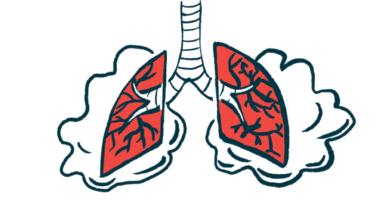Analysis of Trial Data Suggests Ofev Effective in People With Advanced IPF

Shutterstock
Ofev (nintedanib) limits the decline in lung function in people with idiopathic pulmonary fibrosis (IPF), regardless of the degree of impairment in gas exchange in their lungs, a study suggests.
According to the researchers in the study, “these data support the use of [Ofev] in patients with IPF who have advanced disease.”
The study, “Efficacy and safety of nintedanib in patients with advanced idiopathic pulmonary fibrosis,” was published in the journal BMC Pulmonary Medicine.
Ofev, marketed by Boehringer Ingelheim, is an approved medication for the treatment of IPF. It works by blocking molecular signals that promote fibrosis, or tissue scarring.
The treatment has been tested in multiple Phase 3 clinical trials, including INPULSIS (NCT01335464 and NCT01335477) and INSTAGE (NCT02802345). In the former, Ofev was compared with a placebo, while the latter compared Ofev treatment alone or in combination with sildenafil, an approved treatment for pulmonary arterial hypertension, sold under the brand name Revatio.
An important distinction between these two trials in terms of enrollment criteria concerns a measure called diffusing capacity of the lung for carbon monoxide (DLCO) — the rate of transfer of gas from the lungs into the bloodstream.
INPULSIS enrolled participants with 30–79% predicted DLCO, while INSTAGE enrolled participants with 35% or less predicted DLCO. In practical terms, the latter represents more advanced disease.
In the new study, researchers analyzed data from these clinical trials to compare the efficacy of Ofev in individuals with different DLCO measurements before treatment — essentially, comparing the therapy’s effectiveness in people with more or less advanced IPF.
The primary outcome examined was change in lung function, as measured by forced vital capacity (FVC; how much air a person can expel), over time. Higher FVC scores represent better lung function.
Changes in quality of life were also assessed. These were measured using the St. George’s Respiratory Questionnaire (SGRQ); in which lower scores indicate better quality of life.
In total, 638 patients in INPULSIS and 136 in the INSTAGE trial received Ofev alone. Their data was compared with that of 423 INPULSIS participants who received a placebo.
At baseline, meaning before treatment, the average DLCO was significantly higher in INPULSIS patients than in INSTAGE (47.2% vs. 25.6% predicted), in accordance with the eligibility criteria. Additionally, INPULSIS participants had higher FVC and lower SGRQ scores at baseline, indicating better health-related quality of life.
After 24 weeks, the average FVC decline with Ofev treatment was 52.8 mL in INPULSIS and 58.2 mL in INSTAGE, while it was 106.4 mL for those given placebo. SGRQ increased by an average of 1.05 for Ofev-treated participants in INPULSIS, 2.42 points for those in INSTAGE, and by 1.78 for participants given placebo.
“Here we have shown, based on data from the INPULSIS and INSTAGE trials, that [Ofev] appears to have a similar effect on FVC decline over 24 weeks in patients with IPF irrespective of their severity of gas exchange impairment at baseline,” the researchers wrote.
Changes in quality of life were small, and not significantly different between the groups, which is “consistent with previous studies showing that small changes in FVC are not associated with meaningful changes in the patient-reported outcomes commonly used in patients with IPF,” the researchers wrote.
The safety profile of Ofev was similar in both trials. The most common side effect was diarrhea, affecting about half of Ofev-treated participants in both trials, and about 16% of participants given placebo.
Serious adverse events, including IPF progression, pneumonia, and heart failure, were significantly more common among Ofev-treated participants in INSTAGE (affecting 32.4%; 44 patients) than in INPULSIS (affecting 16.8%; 107 patients). The researchers noted that this “might be expected in a sicker population.”
Additionally, there were higher rates of exacerbation and deaths in INSTAGE (acute exacerbation in 3.7%; 11% died), than in INPULSIS (acute exacerbation in 0.6%; 2% died). Again, these results most likely reflect differences in disease severity at baseline.
“Based on data from the INSTAGE and INPULSIS trials, [Ofev] had a similar effect on FVC decline over 24 weeks, and a similar safety and tolerability profile, in patients with IPF and more versus less severe impairment in gas exchange,” the researchers wrote.






